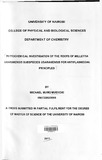| dc.description.abstract | The family Fabaceae is the third largest family of flowering plants with about 20,000 species in 650 genera. The family is subdivided into three sub-families, namely Caesalpinoideae, Mimosoideae and Papilionoideae sub-families, The genus Millettia belongs to the sub-family Papilionoideae which is kwown to elaborate prenylated flavonoids and isoflavonoids. These compounds possess a wide range of biological activities, the most prominent being anti-inflammatory, anti-microbial and antiplasmodial activities. In this study the anti-plasmodial activities of crude extracts and pure compounds obtained from the root bark of Millettia usaramensis have been investigated.
The dried and ground root bark of Millettia usaramensis was exhaustively extracted with CH2CI2/MeOH (1: 1) by cold percolation at room temperature. The extract was subjected to a combination of chromatographic techniques leading to the isolation of ten compounds. These were identified as the rotenoids, usararotenoid-A (6), usararotenoidC (9), 12a-epimillettosin (8), 12-dihydrousararotenoid-A (7), 12-dihydrousararotenoid-B (2), 12-dihydrousararotenoid-C (3); the chalcones, 4'-O-geranylisoliquiritigenin (10), 4- O-geranylisoliquiritigenin (1); the flavanone, 4'-geranyloxy-7-hydroxyflavanone (4) and the cinnamyl alcohol 4-geranyloxycinnamyl alcohol (5).
The chalcone, 4-0-geranylisoliquiritigenin (1), the flavanone, 4' -geranyloxy-7- hydroxyflavanone (4) and the dihydrorotenoids, 12-dihydrousararotenoid-B (2) as well as 12 dihydrousararotenoid-C (3) are new compounds. The cinnamyl alcohol derivative, 4-geranyloxycinnamyl alcohol (5) is reported here for the first time from this genus. The identification of these compounds was based on spectroscopic evidence including 1 H NMR, 13C NMR, HMBC, HMQC, COSY and MS.
The in-vitro antiplasmodial activities of some of the isolated compounds was tested against the chloroquine-resistant (W2) strain of Plasmodium falciparum. The rotenoid 8 together with the flavanone 4 and the chalcone 10 showed moderate antiplasmodial activities with ICso values of 3.1,4.1 and 1.6 j.Jg/ml respectively. | en_US |

